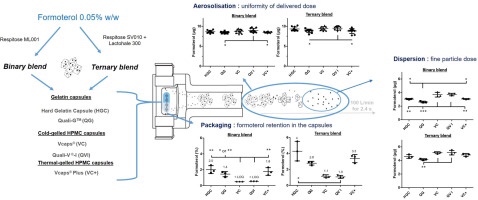Impact of capsule type on aerodynamic performance of inhalation products: a case study using a formoterol-lactose binary or ternary blend

The aerodynamic performance of a dry powder for inhalation depends on the formulation and the dry powder inhaler (DPI). In the case of capsule-based DPIs, the capsule also plays a role in the powder aerosolisation and the dispersion of the micronized drug during the inhalation. This study evaluated the impact of gelatine capsules (Quali-GTM and Hard Gelatine Capsules for DPIs), cold-gelled hypromellose (HPMC) capsules (Quali-V®-I and Vcaps®) and thermal-gelled HPMC capsules (Vcaps®Plus) from Qualicaps® and Capsugel® respectively, on the delivered dose (DD), fine particle dose (FPD), and capsule retention for formoterol-lactose binary and ternary blends. This study used a low resistance Axahaler® DPI based on the RS01 design (Plastiape, Italy). Similar trends were observed with the different capsule types that packaged both dry powder formulations. The highest DD and FPD and the lowest formoterol capsule retention were observed with cold-gelled HPMC capsules such as Quali-V-I® and Vcaps®, without significant differences between these capsules (p > 0.05, one-way ANOVA with Newman-Keuls post-hoc test) for both dry powders. Therefore, the capsule composition and manufacturing process have an influence on aerodynamic performance. In addition, the ternary blend showed higher DDs and FPDs but also higher capsule retention in comparison to the binary blend.

